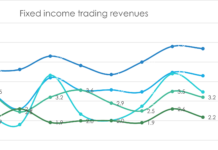By Vineet Naik.
European bond market structure is likely to diverge further from the US, as a result of the different investment models which are popular in the region, according to analyst firm Greenwich Associates, in its report entitled ‘Understanding European Bond Markets in their Local Context’.
It noted several existing differences between US and European markets. For example, there is the lack of a central fiscal authority in Europe. This means that sovereign debt markets are organised around the member states which have a range of credit ratings, from Germany’s AAA rated bonds to Greece’s B+. Also notable are the highly contrasting turnover ratios for sovereign debt between the US and Europe – 3.3% of all outstanding US Treasuries trade every day, as compared with 1.5% in Germany.
In fact, Greenwich Associates suggest that the European government bond market is more easily compared with the municipal bond market in the US. Clear similarities are the presence in both cases of relatively strong monetary and fiscal constraints, and the parallel ambiguity of a redenomination risk in the Eurozone and the lack of an explicit bankruptcy code for US states.
Looking ahead, change on the trading desk will driven by the use of technology by non-dealers to reduce costs and improve efficiency in order to compete with, or replace, dealers. The pace of change between the US and Europe will differ, this can particularly be seen in the increasing use of e-trading, with the only significant difference between asset classes being the rate of growth. Europe, which has broadly seen a greater adoption of e-trading, has greater reliance on futures trading, which is 100% electronic, as a consequence of its structural challenges.
The emergence of the all-to-all platform, noticeably MarketAxess’ OpenTrading, has seen robust growth in the US, the report says, however much of this liquidity has been provided by firms that are conducting the create-redeem arbitrage for fixed-income exchange-traded funds (ETFs). Techniques developed here have been key to the emergence of what Greenwich believes may be the next important shift in corporate bond market structure: the move to list trading. List trading functionality typically allows market participants to upload a list of orders, which can then be matched against multiple counterparties in order to execute many trades simultaneously. For passive funds, which see a massive spike in trading volume at points where portfolios need to be rebalanced, often with relatively small orders, this provides real efficiency.
However, Greenwich says that the different structure of the bond market in Europe, and the fact that ETFs do not have as much traction in the region, means that all-to-all models may not be as successful.
The analyst house concludes that it is likely that Europe will generate many of its own innovations hand-in-hand with governments and central banks, since at present 32% of corporate bonds in Europe are held by euro area monetary authorities, of which only €100 billion is non-financial corporate (NFC) debt.
Moreover, the regulatory wave in the US has largely crested – it has been ten years since the Lehman bankruptcy, while in Europe it is yet to crest since the crisis metastasized into the Eurozone crisis and concluded more recently.
“This is due to the financial crisis playing out differently in Europe, but also because the project of integrating the European economy has not been completed, and improving the quality of the bond market is something regulators are thinking deeply about.” says Ken Monahan of Greenwich Associates.
©Markets Media Europe 2025












